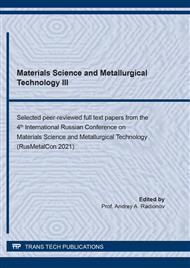[1]
Z. Peng, D. Gregurek, P.J. Mackey, Modeling, simulation, and developments of metallurgical processes, JOM. 67 (2015) 425-426.
DOI: 10.1007/s11837-014-1249-8
Google Scholar
[2]
N.G. Ageev, Modeling of Processes and Objects in Metallurgy, UrFU Publ. House, Yekaterinburg, (2016).
Google Scholar
[3]
Y. Ren, H. Bao, Modeling and simulation of metallurgical process based on hybrid petri net, IOP Conf. Series: Materials Science and Engineering. 157 (2016) 012018.
DOI: 10.1088/1757-899x/157/1/012018
Google Scholar
[4]
M. Satetnus, J. Pieprzyca, T. Merder, Physical modelling of metallurgical processes, MSF. 879 (2016) 1685-1690.
DOI: 10.4028/www.scientific.net/msf.879.1685
Google Scholar
[5]
G.B. Sinyayev, N.A. Vatolin, B.G. Trusov, G.K. Moiseyev, Use of Computers for Thermodynamic Computing of Metallurgical Processes, Nauka, Moscow, (1982).
Google Scholar
[6]
S. Watanasiri, S. Anavi, M.W. Wadsley, Modeling metallurgical processes using a chemical-engineering simulator, Fluid Phase Equilibria. 82 (1993) 55-62.
DOI: 10.1016/0378-3812(93)87128-n
Google Scholar
[7]
M. Li, J. Zhou, C. Tong, W. Zhang, H. Li, Mathematical model of whole-process calculation for bottom-blowing copper smelting, Metall. Res. Technol. 115 (2018) 107.
DOI: 10.1051/metal/2017078
Google Scholar
[8]
N.V. Nemchinova, S.S. Belsky, A.V. Aksenov, A.A. Vasilyev, Using free energy minimization method for metallurgical process studies, Proceedings of Irkutsk State Technical University. 3 (2014) 151-158.
Google Scholar
[9]
N.V. Nemchinova, V.A. Bychinskii, S.S. Bel'skii, V.E. Klets, Basic physicochemical model of carbothermic smelting of silicon, Russian Journal of NonFerrous Metals. 4 (2008) 269-276.
DOI: 10.3103/s1067821208040111
Google Scholar
[10]
A.A. Tyutrin, A.K. Timofeev, Application of mathematical modeling methods in studying the processes of obtaining and refining metallurgical nitrogen, Modern Problems of Science and Education. 4 (2012) 126.
Google Scholar
[11]
N.V. Nemchinova M.S. Leonova, A.K. Timofeev, Study of the metallurgical silicon production process using pelletized charge by the thermodynamic modeling method, Proceedings of Irkutsk State Technical University. 7 (2016) 162-171.
DOI: 10.21285/1814-3520-2016-7-162-171
Google Scholar
[12]
N.V. Nemchinova, A.A. Tyutrin, V.M. Salov, Mathematical model of silicon smelting process basing on pelletized charge from technogenic raw materials, IOP Conf. Series: Materials Science and Engineering. 327 (2018) 022073.
DOI: 10.1088/1757-899x/327/2/022073
Google Scholar
[13]
M.P. Zykova, V.Y. Krolevetskaya, E.N. Mozhevitina, E.M. Gavrishchuk, I.C. Avetissov, Investigation of the phase diagram of the Zn-Se-Fe ternary system for laser application, Izvestiya Vysshikh Uchebnykh Zavedenii. Materialy Elektronnoi Tekhnikii. 19 (2016) 87-94.
DOI: 10.17073/1609-3577-2016-2-87-94
Google Scholar
[14]
M. Cross, D. McBride, N. Croft, Computation modeling of metallurgical processes: achievements and challenges, The Minerals, Metals & Materials Society. (2014) 359-366.
Google Scholar
[15]
V.G. Lisienko, S.I. Holod, V.P. Zhukov, Modeling of metallurgical process of copper fire refining, VII All-Russian Scientific and Practical Conference of Students, Graduate Students and Young Scientists on Heat Engineering and Computer Science in Education, KnE Engineering. (2018) 241-250.
DOI: 10.18502/keg.v3i5.2676
Google Scholar
[16]
B. Peters, Advanced Simulation Technologies of Metallurgical Processing, Metals. 10(6) (2020) 829.
Google Scholar
[17]
G.G. Mikhailov, L.A. Makrovets, O.V. Samoilova, Thermodynamic modeling of phase diagrams of binary and ternary oxide systems belonging to the FeO‒MgO‒MnO‒Al2O3 system, Novye Ogneupory. 6 (2020) 47-50.
DOI: 10.17073/1683-4518-2020-6-47-50
Google Scholar
[18]
D.A. Kulik, T. Wagner, S.V. Dmytrieva, G. Kosakowski, F.F. Hingerl, K.V. Chudnenko, GEM-Selektor geochemical modeling package: revised algorithm and GEMS3K numerical kernel for coupled simulation codes, U.R. Berner, Computational Geosciences. 17 (2013) 1-24.
DOI: 10.1007/s10596-012-9310-6
Google Scholar
[19]
E.C. Dragna, A. Ioana, N. Constantin, Methods of steel manufacturing - The electric arc furnace, IOP Conf. Series: Materials Science and Engineering. 294 (2018) 012017.
DOI: 10.1088/1757-899x/294/1/012017
Google Scholar
[20]
O.V. Avchenko, K.V. Chudnenko, I.A. Aleksandrov, Fundamentals of Physico-Chemical Modeling of Mineral Systems, Nauka, Moscow, (2009).
Google Scholar
[21]
M.W. Chase, JANAF Thermochemical Tables, third ed., Part I, Al–Co, J. of Phys. and Chem. Ref. Data, V. 14, Supplement N 1, (1985).
Google Scholar
[22]
R.A. Robie, B.S. Hemingway, Thermodynamic Properties of Minerals and Related Substances at 298.15 K and 1 Bar (105 Pascals) Pressure and at Higher Temperatures, U.S. Geological Survey Bulletin, U.S. Government printing Office, Washington, (1995).
DOI: 10.3133/b1452
Google Scholar
[23]
T.J.B. Holland, R. Powell, An internally consistent thermodynamic data set for phases of petrological interest, J. of Metamorphic Geology. 3 (1998) 309-343.
DOI: 10.1111/j.1525-1314.1998.00140.x
Google Scholar
[24]
G.G. Mineev, T.S. Mineeva, I.A. Zhuchkov, E.V. Zelinskaya, Theory of Metallurgical Processes, ISTU Publ., Irkutsk, (2010).
Google Scholar


